Peace Pagoda
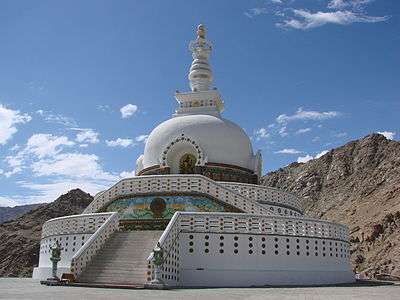
A Peace Pagoda is a Buddhist stupa; a monument to inspire peace, designed to provide a focus for people of all races and creeds, and to help unite them in their search for world peace. Most (though not all) peace pagodas built since World War II have been built under the guidance of Nichidatsu Fujii (1885–1985), a Buddhist monk from Japan and founder of the Nipponzan-Myōhōji Buddhist Order. Fujii was greatly inspired by his meeting with Mahatma Gandhi in 1931 and decided to devote his life to promoting non-violence. In 1947, he began constructing Peace Pagodas as shrines to World peace.[1]
Peace Pagodas were built as a symbol of peace in Japanese cities including Hiroshima and Nagasaki where the atomic bombs took the lives of over 150,000 people, almost all of whom were civilian, at the end of World War II. By 2000, eighty Peace Pagodas had been built around the world in Europe, Asia, and the United States.
The Nipponzan-Myōhōji monks of the New England Peace Pagoda were awarded the Courage of Conscience award June 5, 1998 in Sherborn, Massachusetts.[2]
Asia
Rajgir, India

The Rajgir Vishwa Shanti Stupa/World Peace Pagoda (25°00′16″N 85°26′40″E / 25.004553°N 85.444539°E) was completed in 1969 at Rajgir hills near Rajgir, near the site where the Buddha is believed to have preached the Lotus Sutra. The dedication coincided with the 100th anniversary of the birth of Mahatma Gandhi. The site also includes a Nipponzan Myohoji temple.[3]
Darjeeling, India

The shanthi stupas in India were established by Fuji Guru, a close friend of Mahatma Gandhi, for World Peace. The Nipponzan Myōhōji Buddhist temple at Charlimont in Darjeeling (27°01′39″N 88°15′32″E / 27.027585°N 88.259012°E) is one of them. Work on the Stupa began in 1972 and it was dedicated on 1 November 1992.
Delhi, India
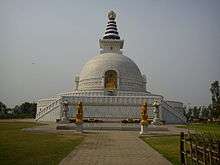
A Vishwa Shanti Stupa/World Peace Pagoda in New Delhi (28°36′08″N 77°15′12″E / 28.602352°N 77.253413°E) was inaugurated on 20th. November 2008 by monks and nuns of Nipponzan-Myōhōji, the Dalai Lama and the Lt. Governor of Delhi. It is situated in Millennium Indraprastha Park, North-East of Humayun's Tomb, adjacent to Delhi Ring Road.
A traditional Japanese garden has been constructed in the area around the stupa. The garden is a joint project by the Fujii Guruji Vishwa Shanti Stupa Committee and the Delhi Development Authority.
Dhauli Giri, Bhubaneswar, Orissa, India
The Dhauli Giri Shanti Stupa (Peace Pagoda) was built in Bhubaneswar, Orissa State, India (20°11′33″N 85°50′22″E / 20.192392°N 85.839454°E) during a two-year period, and was inaugurated on November 8, 1972. It was established by Sri Nitya Nanda Kanungo, Governor of Bihar, with the spiritual guidance of Nichidatsu Fujii (Fujii Guruji), whose monks helped build the Peace Pagoda.[4]
Ladakh, India
The Shanti Stupa in Ladakh (Jammu and Kashmir) was built by Nipponzan-Myōhōji monks, headed by Head monk Nakamura, with the help of local people. The Shanti Stupa holds the relics of the Buddha at its base, enshrined by the 14th Dalai Lama himself[5] It is situated at a hilltop in Changspa village providing a bird's eye view of Leh town and the surrounding mountain peaks. The 14th and current Dalai Lama inaugurated the Shanti Stupa in August 1985.[6]
Vaishali, India
The stupa at Vaishali was inaugurated 23 October 1996.,.[7][8] Vaishali is an important place in the life of the Buddha.
Wardha, India
Vishwa Shanti stupa was a dream of Fujii guruji (as called by Mahatma Gandhi). It is beside Gitai Mandir. It is a large stupa of white color. Statues of Buddha are mounted on the stupa, facing in four directions. It also has a small Japanese Buddhist temple with a large park.There is a temple near the stupa where prayers are done for universal peace.
Hanaokayama, Japan
Work on Hanaokayama Peace Pagoda, the first Peace Pagoda constructed by Nipponzan Myohoji Japanese Buddhist monks, began in 1947 at Kumamoto (32°47′48″N 130°41′09″E / 32.796605°N 130.685959°E) with basic hand tools. It took seven years to build, being completed in 1954.
Sapporo, Japan
This Peace Pagoda (Stupa) was built by Nipponzan-Myōhōji monks in 1959 halfway up Mount Moiwa (43°01′49″N 141°19′51″E / 43.030385°N 141.330728°E). It was built to commemorate peace after World War II and can be seen from almost anywhere in Sapporo. It contains some of the ashes of the Buddha that were presented to the Emperor of Japan by Prime Minister Nehru in 1954. Later, another part of these were presented to Mikhail Gorbachev by the famous Nipponzan-Myōhōji monk, Junsei Terasawa.
Hiroshima, Japan

The Hiroshima Peace Pagoda [9] (34°24′21″N 132°28′41″E / 34.4058702°N 132.4779358°E) was built in 1966 by Nipponzan Myohoji Buddhist monks. It commemorate the lives lost in the A-bomb blast, and contains gifts of Buddha's ashes from the then Prime Minister of India and Mongolian Buddhists.
Narita-shi, Chiba-ken, Japan
Built in 1984, dedicated May 13, 2001, the peace pagoda at Narita-shi in Chiba Prefecture, Japan (35°44′29″N 140°23′54″E / 35.741317°N 140.398277°E) is 58 m high and situated on a small hill.
Gotemba, Shizuoka, Japan
Founded in 1964, the Gotemba Peace Pagoda in Shizuoka Prefecture, Japan (35°17′05″N 138°57′23″E / 35.284637°N 138.956364°E) includes a Nipponzan Myohoji temple.
Jeju Island, Korea
The Stupa is built in Jeju Island on the site where Venerable Masters Bowoo (d. 1565) and Jiahn (d. 1729) died. They gave their lives for Buddhism. The Stupa is the centre of many activities for the propagation of world peace and the unification of Korea. One such activity is the Lotus Sutra writing movement, and on August 15 each year people come and place hand-written copies of the Lotus Sutra into the Pagoda. This stupa is not associated with Nipponzan-Myōhōji.
Lumbini, Nepal
The Lumbini Shanti Stupa/Peace Pagoda[10] (27°29′56″N 83°16′35″E / 27.4989001°N 83.2762546°E) in Nepal was constructed by Nipponzan Myohoji monks and dedicated in November 2001 at the Buddhist pilgrimage site in kapilvastu district lumbini zone Nepal, where Queen Mayadevi is said to have given birth to Siddhartha Gautama, who in turn, as the Buddha Gautama, gave birth to the Buddhist tradition.
Pokhara, Nepal
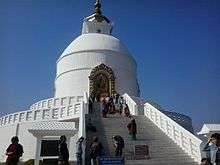
Balanced on a narrow ridge high above Phewa Tal, the brilliant-white Shanti Stupa in Pokhara is a massive Buddhist stupa which was constructed by Buddhist monks from the Japanese Nipponzan Myōhōji organisation. Besides being an impressive sight in itself, the shrine is a vantage point which offers spectacular views of the Annapurna range and Pokhara city.The shining golden statue depicts the Buddha in the posture he assumed when he was born.
Ampara, Sri Lanka

The Ampara Peace Pagoda (7°17′07″N 81°39′14″E / 7.2852855°N 81.6539499°E) was built by Nipponzan monks under the leadership of Nichidatsu Fujii and was inaugurated on February 27, 1988.[11]
Bandarawela, Sri Lanka
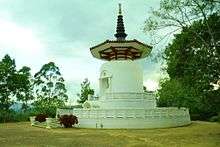
The Bandarawela Peace Pagoda [12] (also known Sama Chethiya in Sinhala) (6°49′28″N 80°59′09″E / 6.824508°N 80.98587°E) is located between the towns of Bandarawela Etampitiya road 6 Kilometers towards Bandarawela to Etampitiya. It was completed by Niponzan Myohoji monks in 1982.
Unawatuna, Sri Lanka
The Unawatuna Peace Pagoda (6°00′57″N 80°14′16″E / 6.0158585°N 80.2377972°E), built by Nipponzan Myohoji monks, is on the headland between Unawatuna and Galle.[13]
Walapane, Sri Lanka
The Walapane Peace Pagoda (7°05′23″N 80°51′40″E / 7.089642°N 80.861027°E), built by Nichidatsu Fuhi monk, is located on Walapane, Central Province of Sri Lanka. . This is also called Japanese Sama Viharaya Walapane.
Australia
Brisbane, Australia
Created by the Kingdom of Nepal for the 1988 World Exposition, Brisbane's World Expo '88, the Brisbane Nepal Peace Pagoda is now a permanent commemorative structure of the Expo. It is located at the transformed Expo site, South Bank Parklands.
The three-story Pagoda was constructed of 80 tons of art-carved Nepalese Terai timbers and assembled on the Expo site for the World Expo´88. It was relocated to its new riverfront location at the conclusion of the Expo for the opening of the Parklands in 1992. It now features commemorative displays of the Expo and is a place for quiet and reflection. It features a Peace Bell, and there is a Peace Post in the Pagoda garden. The Peace Pagoda in Brisbane was built by German architect Jochen Reier and architect Dean Ricker for the World EXPO´88 on behalf of the Kingdom of Nepal. Architect Jochen Reier has also constructed the Peace Pagoda in Munich, Germany, for the IGA ´83 and the World EXPO´90 Peace Pagoda in Osaka, Japan.
Europe
Munich, Germany
The Peace Pagoda in Munich was built by German architect Jochen Reier (APAC) on behalf of the Kingdom of Nepal in 1982-1983. The temple has been constructed with 80 tons of precious Sissam timber (rose wood) logged in the Terai (lowlands of Nepal) and was then beautifully art-carved by hand. Over 300 Nepalese artisans in the Kathmandu area helped building it. The Kingdom of Nepal was awarded with the gold medal for best nation building of the IGA´83 in Munich. Today the Peace Pagoda is part of Munich Westpark because thousands of citizens and visitors helped to keep the "Asian Essemble" - and especially this Nepalese Shiva Pagoda - as a constantly remaining symbol of World Peace.[14]
Vienna, Austria
The Vienna Peace Pagoda,[15] on the Danube River, (48°11′28″N 16°27′17″E / 48.1912047°N 16.4548101°E) was built on land donated by Elisabeth Lindmayer. Nipponzan Myohoji monks constructed the Pagoda, which was completed in 1983, the first peace pagoda in continental Europe. The Nipponzan Myohoji order led by Rev. Gyosei Masunaga have been active here for 25 years.[16]
Birmingham, England
On 26 June 1998, the Dhamma Talaka Pagoda was dedicated in the Ladywood district of Birmingham. The Burmese monk and scholar, Aggamahapandita Rewata Dhamma, was the prime mover behind the planning of the pagoda and the new monastic complex that developed on the same grounds. Enshrined above its dome are Buddha relics once belonging to the Burmese royal family. The building therefore serves as a pilgrimage site and a focus for the Burmese community in Britain.
Milton Keynes, England
The Milton Keynes Peace Pagoda (52°03′28″N 0°43′32″W / 52.057697°N 0.725436°W) was completed in 1980 at the western edge of Willen lake in Willen, Milton Keynes. This was the first Peace Pagoda in the western world.[17] There is a Nipponzan-Myōhōji Order temple and monastery nearby (52°03′20″N 0°43′34″W / 52.055436°N 0.726181°W).
London, England
The London Peace Pagoda (51°28′55″N 0°09′32″W / 51.482018°N 0.159025°W) was completed[18] in 1985 on the south side of the River Thames in Battersea Park, London. Permission to build it was the last legislative act of the Greater London Council.
Comiso, Italy
The Comiso Peace Pagoda (36°57′45″N 14°38′02″E / 36.9625422°N 14.6339001°E), built by Nipponzan Myohoji monks, was dedicated on 24 May 1998, the Reverend Morishita[19] at Comiso (Contrada Canicarao, 100) in Sicily, Italy near the NATO base there.
Latvia
The Peace Pagoda in Latvia (56°39′46″N 23°57′33″E / 56.662912°N 23.959158°E) was opened on 28 June 2014 near Garoza village in Salgale parish, Ozolnieki Municipality.[20]
North America
St Norbert, Manitoba, Canada
A stupa has been constructed at the St Norbert Arts Centre in St. Norbert (Winnipeg, Manitoba), Canada.
Los Álamos, Valle de Bravo, Mexico
The Asociación Cultural Tibetana A.C. ("Garuda") is constructing a stupa at Los Álamos, Valle de Bravo, Mexico State under the patronage of Tenzin Wangyal Rinpoche.[21]
San Francisco, California
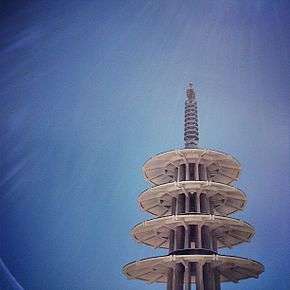
The Peace Pagoda in San Francisco (37°47′06″N 122°25′47″W / 37.785054°N 122.429827°W) is a five-tiered concrete stupa in Nihonmachi (Japantown) between Post and Geary Streets at Buchanan. It is part of the Japan Center complex which opened in 1968. It was designed by Japanese architect Yoshiro Taniguchi and presented to San Francisco by the people of Osaka, Japan. This stupa is not associated with Nipponzan-Myōhōji.
Leverett, Massachusetts
The New England Peace Pagoda (42°29′56″N 72°29′28″W / 42.498994°N 72.491108°W) is the first Nipponzan-Myōhōji Peace Pagoda to be built in the US and was completed in 1985. The Franklin County Technical School brought students from their electrical, plumbing, and carpentry shops to assist in building the temple.[22]
Grafton, New York
The Grafton Peace Pagoda in Petersburgh, New York (42°45′04″N 73°24′32″W / 42.751109°N 73.408756°W) was dedicated in 1993. The site includes a temple, gardens, pond and the pagoda. Each year on September 11, a group of marchers begin a walk at the Grafton Peace Pagoda Site and end in New York City two weeks later.
Great Smoky Mountains
As of January 2015, the Great Smoky Mountains Peace Pagoda (35°52′17″N 83°10′13″W / 35.8713972°N 83.1702692°W) is under construction.[23] Land for the construction of the Great Smoky Mountains Peace Pagoda was purchased in 2000 and, by the end of 2014, a temple, gardens, Stone Pagoda, Spirit Garden, and guest house had been completed. Construction of the Peace Pagoda/Stupa itself is ongoing. The architectural design of Darjeeling Peace Pagoda is the model for the Peace Pagoda in the Smoky Mountains.
Gallery
 Darjeeling, India
Darjeeling, India Dhauli Giri Peace Pagoda, Bhubaneswar, India
Dhauli Giri Peace Pagoda, Bhubaneswar, India Vishwa Shanti Stupa Delhi
Vishwa Shanti Stupa Delhi Ladakh, India
Ladakh, India Peace Pagoda, Hiroshima, Japan February 9, 2013
Peace Pagoda, Hiroshima, Japan February 9, 2013- Sapporo, Japan
 Gotemba, Shizuoka, Japan
Gotemba, Shizuoka, Japan World Peace Pagoda, Pokhara, Nepal
World Peace Pagoda, Pokhara, Nepal The Brisbane Nepal Peace Pagoda at South Bank Parklands.
The Brisbane Nepal Peace Pagoda at South Bank Parklands.- Vienna, Austria
 Dhamma Talaka, Birmingham, England
Dhamma Talaka, Birmingham, England The Peace Pagoda in Willen, Milton Keynes, England
The Peace Pagoda in Willen, Milton Keynes, England Peace Pagoda in London, England
Peace Pagoda in London, England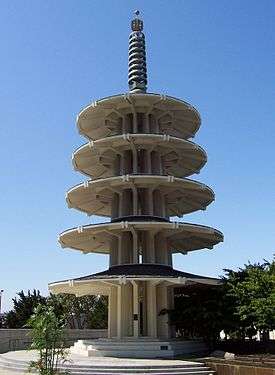 Peace Pagoda in Japan Center, San Francisco, California, USA
Peace Pagoda in Japan Center, San Francisco, California, USA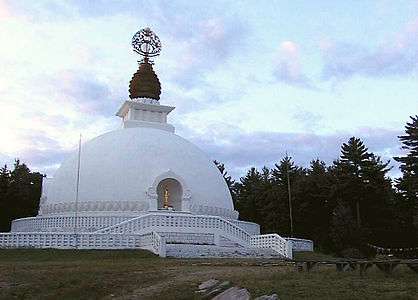 The New England Peace Pagoda in Leverett, Massachusetts USA
The New England Peace Pagoda in Leverett, Massachusetts USA Peace Pagoda, Grafton, New York USA
Peace Pagoda, Grafton, New York USA- Peace Pagoda (Buddhist stupa) in Ampra, Sri Lanka.
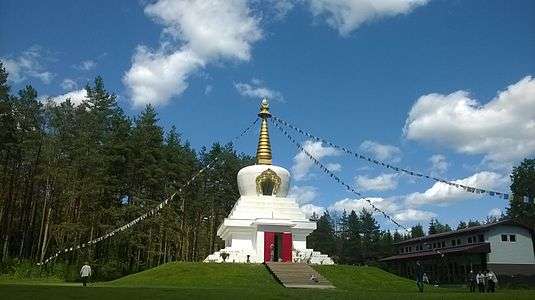 Peace Pagoda in Latvia
Peace Pagoda in Latvia
See also
References
- ↑ http://www.buddhistinformation.com/nichidatsu_fujii.htm
- ↑ The Peace Abbey Courage of Conscience Recipients List
- ↑ 'India' page 252 pub Insight Guides ISBN 978-981-258-629-2
- ↑ Dhauli Giri Peace Pagoda
- ↑ "Leh". NDTV.
- ↑ "Shanti Stupa". Buddhist-temples.com. Retrieved October 19, 2009.
- ↑ Nipponzan Myohoji Vaishali Dojo Includes picture of the Stupa
- ↑ Vaishali World Peace Pagoda
- ↑ Peace Pagoda, Hiroshima, Japan
- ↑ World Peace Pagoda, Lumbini
- ↑ Ampara Peace Pagoda
- ↑ http://amazinglanka.com/heritage/japanese_pagoda_galle/japanese_pagoda_galle.php Bandarawela Peace Pagoda
- ↑ Travel blog at Galle
- ↑ WERDEGANG DER NEPALESISCHEN FRIEDENS PAGODE IN MUENCHEN IM RAHMEN DER INTERNATIONALEN GARTENBAUAUSTELLUNG (IGA’83) PROJEKTBEGINN: JANUAR 1980
- ↑ Vienna Peace Pagoda
- ↑ PeacePagoda.net(in German)
- ↑ Places to visit in Milton Keynes: the Peace Pagoda
- ↑ Peace Pagoda in Battersea Park
- ↑ Rev. Morishita
- ↑ Peace Pagoda Latvia
- ↑ Garuda
- ↑ RELIGION JOURNAL; Peace Pagoda Grounds a Buddhist Group in New England
- ↑ Great Smoky Mountains Peace Pagoda construction web site
External links
| Wikimedia Commons has media related to Peace Pagodas. |
- Dharmawalk.org: Information on Nichidatsu Fujii, Peace Pagodas and the work of Nipponzan Myōhōji.
- The New England Peace Pagoda, based in Leverett
- The official website for the Milton Keynes Nipponzan Myōhōji Peace Pagoda
- Pictures of the Milton Keynes Nipponzan Myōhōji Peace Pagoda.
- 360 degree panoramic view from Stupa at Pokhara, Nepal
- Grafton Peace Pagoda
- BUDDHISM FOR WORLD PEACE: Words of Nichidatsu Fujii at Milton Keynes in 1979, Translated by Yumiko Miyazaki, Japan-Bharat Sarvodaya Mitrata Sangha, 1980.
- Location on DigiLondon
- Buddha Sharira Stupa for Peace and Unification
- Opening ceremony of the 29th international Peace Pagoda project, Barrydale South Africa 2000
- Panoramic picture of stupa on the shore of the Danube
